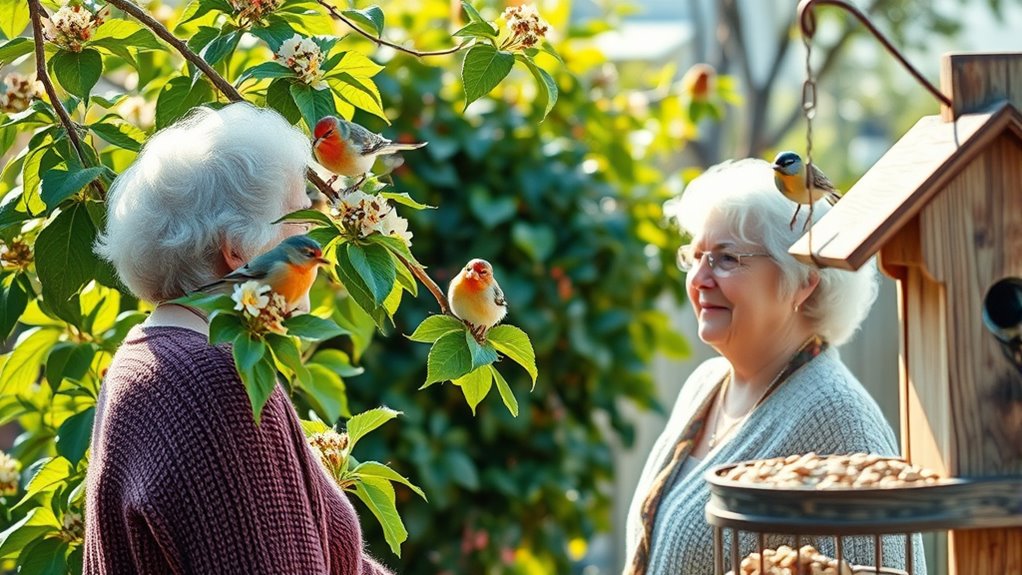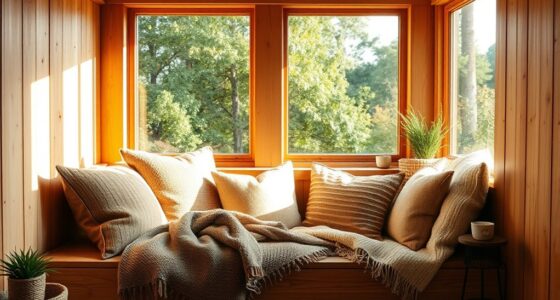To attract wildlife that seniors enjoy, position bird feeders in quiet, sheltered spots at eye level, near shrubs or trees to provide cover. Use native plants like berries, sunflowers, and coneflowers to supply seeds, nectar, and shelter. Combine thoughtful feeder placement with native landscaping to create a safe, inviting habitat that brings a variety of colorful birds closer. Keep exploring to discover more simple ways to turn your yard into a wildlife-friendly paradise.
Key Takeaways
- Place feeders at eye level in quiet, sheltered spots to make viewing comfortable and safe for seniors.
- Use native plants nearby to provide natural food sources and attractive habitat for a variety of birds.
- Choose feeder locations away from pests and predators, ensuring a peaceful environment for extended observation.
- Incorporate easy-to-maintain native shrubs and flowers that attract birds with berries and nectar year-round.
- Create accessible, inviting spaces that encourage seniors to spend relaxed, enjoyable time watching diverse bird species.

Ever wonder how much joy you can find just by watching birds in your own backyard? It’s a simple pleasure that can bring a sense of peace and connection, especially for seniors who enjoy spending time outdoors. The key to attracting a variety of feathered visitors starts with thoughtful bird feeder placement. Position your feeders in quiet, sheltered spots where birds feel safe from predators and harsh weather. Ideally, place feeders near shrubs or trees that offer cover and quick escape routes. Keep them at eye level so you can easily observe the action without straining or disturbing the birds. Also, try to avoid locations directly under feeding stations, as spilled seed can attract unwanted pests. By carefully choosing where you hang your feeders, you create a welcoming environment that invites a diverse array of species to visit regularly.
Another essential element is native plant selection. Incorporating native plants into your yard not only enhances its beauty but also provides natural food sources for local birds. Native shrubs, trees, and flowering plants produce seeds, berries, and nectar that attract different species throughout the year. For example, planting native berry-producing shrubs like holly or serviceberry can draw in thrushes and waxwings, while native sunflowers and coneflowers supply nectar and seeds for finches and sparrows. These plants also serve as excellent cover, nesting sites, and perches, making your backyard a more inviting habitat. Additionally, choosing keto-friendly plants can support other wildlife while maintaining your garden’s health. Incorporating native plant conservation efforts can further support local ecosystems and attract even more diverse bird species to your yard. To ensure your plants thrive and attract the desired birds, consider projector bulb maintenance tips for garden lighting or birdhouse illumination, which can enhance nighttime safety and visibility.
Combining strategic bird feeder placement with native plant selection creates a sustainable, inviting environment for your feathered visitors. When you position feeders thoughtfully and support local wildlife with native flora, you’re offering birds not just a quick snack but a safe, resource-rich habitat. This encourages a steady stream of visitors, from colorful songbirds to more elusive species, giving you endless opportunities for observation. It also helps you develop a deeper appreciation for the local ecosystem and the importance of preserving native habitats. As you spend time outdoors, watching your yard come alive with movement and song, you’ll discover that creating a welcoming space for birds is a rewarding way to enjoy nature’s beauty and foster a meaningful connection with the natural world.
Frequently Asked Questions
What Are the Best Bird Species for Beginners?
When choosing beginner-friendly bird species, focus on those that are easy to attract and identify. You should consider bird feeder placement, placing feeders in accessible, safe spots to invite birds like chickadees, sparrows, and finches. These species are resilient, active, and adapt well to feeders. By selecting the right locations and choosing straightforward species, you’ll enjoy a rewarding start to your bird-watching journey and attract a variety of delightful backyard visitors.
How Do I Prevent Squirrels From Stealing Bird Food?
To prevent squirrels from stealing your bird food, you should invest in squirrel-proof feeders designed with weight-activated mechanisms that close off access when a squirrel tries to feed. Additionally, incorporate natural deterrents like spicy seeds or hot pepper blends, which squirrels dislike. Placing feeders away from trees or structures where squirrels can jump from also helps. Combining these strategies keeps your birds fed while discouraging pesky squirrels effectively.
What Is the Ideal Time of Day for Bird-Watching?
You’ll find the best bird-watching times are during dawn and early evening. During dawn, you’ll enjoy the vibrant dawn chorus as birds sing and become active. In the evening, you can catch beautiful sightings as many species settle in for the night. These times offer prime opportunities to observe different birds, making your experience more rewarding. So, set your schedule around these peak moments for the most engaging bird-watching adventures.
How Can I Make My Backyard More Inviting for Birds?
To make your backyard more inviting for birds, focus on birdbath maintenance by regularly cleaning and refilling it with fresh water. Choose native plant selection to provide natural food sources and shelter. Add feeders with seeds and suet, and create shrubbery or trees for cover. These efforts attract a variety of birds, making your yard a lively, welcoming spot that supports local wildlife and offers enjoyable bird-watching opportunities.
Are There Any Safety Tips for Elderly Bird-Watchers?
Think of your bird-watching hobby as a delicate dance—safety comes first. To prevent falls, guarantee your paths are clear, well-lit, and slip-resistant, like a sturdy stage. Make accessibility modifications, such as stable chairs and reachable feeders, so you can enjoy the show without worry. Stay alert and take your time, because the joy of bird-watching is most beautiful when it’s safe and sound.
Conclusion
Just like the timeless beauty of a Van Gogh sunset, your backyard becomes a living masterpiece when you invite wildlife in. With patience and care, you create a sanctuary where feathers and songs fill the air, offering moments of peace and wonder. Remember, as the ancients watched the stars for guidance, you can find joy in the simple act of bird-watching. Embrace this gift of nature, and let it inspire your soul.









